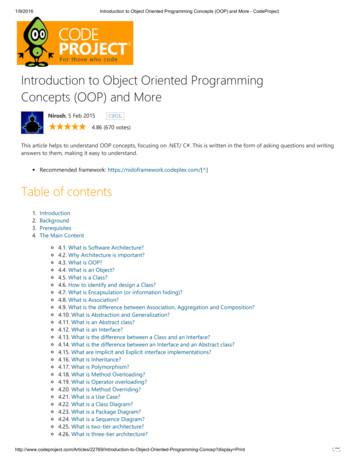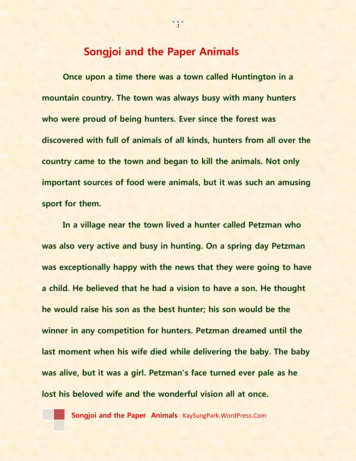MIT6 0001F16 Object Oriented Programming
OBJECT ORIENTEDPROGRAMMING(download slides and .py files ĂŶĚ follow along!)6.0001 LECTURE 86.0001 LECTURE 81
OBJECTS Python supports many different kinds of data12343.14159"Hello"[1, 5, 7, 11, 13]{"CA": "California", "MA": "Massachusetts"} each is an object, and every object has: a type an internal data representation (primitive or composite) a set of procedures for interaction with the object an object is an instance of a type 1234 is an instance of an int "hello" is an instance of a string6.0001 LECTURE 82
OBJECT ORIENTEDPROGRAMMING (OOP) EVERYTHING IN PYTHON IS AN OBJECT (and has a type) can create new objects of some type can manipulate objects can destroy objects explicitly using del or just “forget” about them python system will reclaim destroyed or inaccessibleobjects – called “garbage collection”6.0001 LECTURE 83
WHAT ARE OBJECTS? objects are a data abstractionthat captures (1) an internal representation through data attributes(2) an interface forinteracting with object through methods(aka procedures/functions) defines behaviors buthides implementation6.0001 LECTURE 84
EXAMPLE:[1,2,3,4] has type list how are lists represented internally? linked list of cellsL 1- 2- 3- 4- how to manipulate lists? L[i], L[i:j], len(), min(), max(), del(L[i]) (),L.pop(),L.remove(),L.reverse(), L.sort() internal representation should be private correct behavior may be compromised if you manipulateinternal representation directly6.0001 LECTURE 85
ADVANTAGES OF OOP bundle data into packages together with proceduresthat work on them through well-defined interfaces divide-and-conquer development implement and test behavior of each class separately increased modularity reduces complexity classes make it easy to reuse code many Python modules define new classes each class has a separate environment (no collision onfunction names) inheritance allows subclasses to redefine or extend aselected subset of a superclass’ behavior6.0001 LECTURE 86
Implementing the classUsing the classCREATING AND USING YOUROWN TYPES WITH CLASSES make a distinction between creating a class andusing an instance of the class creating the class involves defining the class name defining class attributes for example, someone wrote code to implement a list class using the class involves creating new instances of objects doing operations on the instances for example, L [1,2] and len(L)6.0001 LECTURE 87
Implementing the classUsing the classDEFINE YOUR OWN TYPES use the class keyword to define a new typeclass Coordinate(object):#define attributes here similar to def, indent code to indicate which statements arepart of the class definition the word object means that Coordinate is a Pythonobject and inherits all its attributes (inheritance next lecture) Coordinate is a subclass of object object is a superclass of Coordinate6.0001 LECTURE 88
WHAT ARE ATTRIBUTES? data and procedures that “belong” to the class data attributes think of data as other objects that make up the class for example, a coordinate is made up of two numbers methods (procedural attributes) think of methods as functions that only work with this class how to interact with the object for example you can define a distance between twocoordinate objects but there is no meaning to a distancebetween two list objects6.0001 LECTURE 89
Implementing the classUsing the classDEFINING HOW TO CREATE ANINSTANCE OF A CLASS first have to define how to create an instance ofobject use a special method called init toinitialize some data attributesclass Coordinate(object):def init (self, x, y):self.x xself.y y6.0001 LECTURE 810
Implementing the classUsing the classACTUALLY CREATING ANINSTANCE OF A CLASSc Coordinate(3,4)origin Coordinate(0,0)print(c.x)print(origin.x) data attributes of an instance are called instancevariables don’t provide argument for self, Python does thisautomatically6.0001 LECTURE 811
WHAT IS A METHOD? procedural attribute, like a function that works onlywith this class Python always passes the object as the first argument convention is to use self as the name of the firstargument of all methods the “.” operator is used to access any attribute a data attribute of an object a method of an object6.0001 LECTURE 812
Implementing the classUsing the classDEFINE A METHOD FOR THECoordinate CLASSclass Coordinate(object):def init (self, x, y):self.x xself.y ydef distance(self, other):x diff sq (self.x-other.x)**2y diff sq (self.y-other.y)**2return (x diff sq y diff sq)**0.5 other than self and dot notation, methods behave justlike functions (take params, do operations, return)6.0001 LECTURE 813
Implementing the classUsing the classHOW TO USE A METHODdef distance(self, other):# code hereUsing the class: conventional way equivalent toc Coordinate(3,4)c Coordinate(3,4)zero Coordinate(0,0)zero nate.distance(c, zero))6.0001 LECTURE 814
PRINT REPRESENTATION OFAN OBJECT c Coordinate(3,4) print(c) main .Coordinate object at 0x7fa918510488 uninformative print representation by default define a str method for a class Python calls the str method when used withprint on your class object you choose what it does! Say that when we print aCoordinate object, want to show print(c) 3,4 6.0001 LECTURE 815
Implementing the classUsing the classDEFINING YOUR OWN PRINTMETHODclass Coordinate(object):def init (self, x, y):self.x xself.y ydef distance(self, other):x diff sq (self.x-other.x)**2y diff sq (self.y-other.y)**2return (x diff sq y diff sq)**0.5def str (self):return " " str(self.x) "," str(self.y) " "6.0001 LECTURE 816
Implementing the classUsing the classWRAPPING YOUR HEADAROUND TYPES AND CLASSES can ask for the type of an object instance c Coordinate(3,4) print(c) 3,4 print(type(c)) class main .Coordinate this makes sense since print(Coordinate) class main .Coordinate print(type(Coordinate)) type 'type' use isinstance() to check if an object is a Coordinate print(isinstance(c, Coordinate))True6.0001 LECTURE 817
SPECIAL OPERATORS , -, , , , len(), print, and many l.html#basic-customization like print, can override these to work with your class define them with double underscores before/afteradd (self, other)sub (self, other)eq (self, other)lt (self, other)len (self)str (self). and others 6.0001 LECTURE 8self otherself - otherself otherself otherlen(self)print self18
EXAMPLE: FRACTIONS create a new type to represent a number as a fraction internal representation is two integers numerator denominator interface a.k.a. methods a.k.a how to interact withFraction objects add, subtract print representation, convert to a float invert the fraction the code for this is in the handout, check it out!6.0001 LECTURE 819
THE POWER OF OOP bundle together objects that share common attributes and procedures that operate on those attributes use abstraction to make a distinction between how toimplement an object vs how to use the object build layers of object abstractions that inheritbehaviors from other classes of objects create our own classes of objects on top of Python’sbasic classes6.0001 LECTURE 820
MIT OpenCourseWarehttps://ocw.mit.edu6.0001 Introduction to Computer Science and Programming in PythonFall 2016For information about citing these materials or our Terms of Use, visit: https://ocw.mit.edu/terms.
OBJECT ORIENTED PROGRAMMING (OOP) EVERYTHING IN PYTHON IS AN OBJECT (and has a type) can create new objects of some type can manipulate objects can destroy objects explicitly using delor just “forget” about t
method dispatch in different object-oriented programming languages. We also include an appendix on object-oriented programming languages, in which we consider the distinction between object-based and object-oriented programming languages and the evolution and notation and process of object-oriented analysis and design, start with Chapters 5 and 6;
object-oriented programming language is based on a kind of old object-oriented programming language. For example, though C language is an object-oriented programming language, it still retains the pointer which is complex but has strong function. But C# improved this problem. C# is a kind of pure object-oriented language.
PROGRAMMING (OOP) EVERYTHING IN PYTHON IS AN OBJECT (and has a type) can create new objects of some type can manipulate objects can destroy objects explicitly using delor just "forget" about them python system will reclaim destroyed or inaccessible objects -called "garbage collection" 6.0001 LECTURE 8 3
It stands for Object Oriented Programming. Object‐Oriented Programming ﴾223﴿ uses a different set of programming languages than old procedural programming languages ﴾& 3DVFDO, etc.﴿. Everything in 223 is grouped as self sustainable "REMHFWV". Hence, you gain reusability by means of four main object‐oriented programming concepts.
The principle of object oriented programming is to combine both data and the associated functions into a single unit called a class. An object in programming means data. Data is therefore predominant in object oriented programming. The concept will become clear with examples. However, in the object oriented paradigm, accessibility of
Object Oriented Programming 7 Purpose of the CoursePurpose of the Course To introduce several programming paradigms including Object-Oriented Programming, Generic Programming, Design Patterns To show how to use these programming schemes with the C programming language to build “good” programs.
Object Class: Independent Protection Layer Object: Safety Instrumented Function SIF-101 Compressor S/D Object: SIF-129 Tower feed S/D Event Data Diagnostics Bypasses Failures Incidences Activations Object Oriented - Functional Safety Object: PSV-134 Tower Object: LT-101 Object Class: Device Object: XS-145 Object: XV-137 Object: PSV-134 Object .
a paper animal. She tried over and over until she could finally fold a paper dog and wished that she could see Son just once more even though she knew that it was not possible. Looking at the paper dog she had made, she felt so weird that the paper dog seemed smiling at her. She felt that she would make more, many more animals out of paper. She collected all the papers in the house and started .























